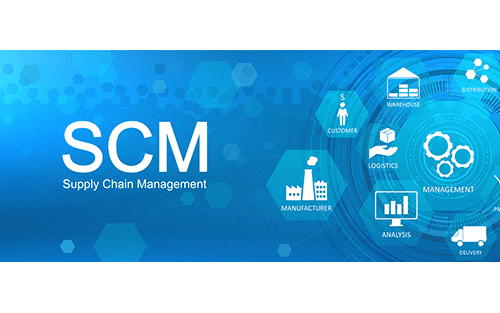Discussing What is Supply chain management and It’s Objectives/Functions/Components
Table of Contents
What is Supply Chain Management ?
Supply chain management is the practise of arranging and supervising supply chain operations in order to achieve (or maintain) a competitive advantage.
Supply chain management is at the core of a business’s operations, including all processes from raw material procurement to final product delivery. What you need to know about supply chain management is how it works, the advantages and difficulties it presents, and the best practises for more successful supply chain management procedures.
Supply Chain Management (SCM) is the process of managing the flow of products and services from raw material manufacture to customer consumption. This procedure necessitates the establishment of a network of suppliers (who act as links in the chain) to facilitate the movement of the product through each step.
Supply Chain Management (SCM) encompasses all actions necessary to get the appropriate product into the hands of the appropriate customer in the right amount and at the right time – from raw material extraction through consumer purchase. SCM is concerned with planning and forecasting, procurement, product assembly, transportation, storage, distribution, sales, and customer support.
SCM experts are engaged in every aspect of the business operation as they work to design and deliver goods that are better, quicker, and cheaper.

What is Supply Chain Management Objective ?
The primary goal of supply chain management is to guarantee that items flow smoothly, efficiently, and flexibly across the supply chain. While supply chain management benefits the whole supply chain, it also benefits certain areas of the primary company. Let us examine these in further detail:
•Supply chain management decreases manufacturing costs by ensuring that raw materials are delivered on time to assembly plants. Businesses may prevent material shortages and manufacturing delays in this manner.
•An effective supply chain management plan may assist reduce the need for a costly warehouse by ensuring that items are delivered quickly from the producer to the retail outlet. Supply chain management minimises buying expenses by reducing warehouses.
•Over time, a supply chain management plan will enable organisations to forecast stock shortages in advance. They may avoid losing prospective sales by analysing data such as their reorder frequency, the quantity of goods purchased, and the number of orders received.
•Supply chain management also ensures that clients get the correct quantity of items at the correct place and time. All of these things contribute to enhanced customer service.

Five Supply Chain Management Functions
The following are the five functions of supply chain management:
1. Acquiring
Purchasing is the first role in supply chain management. Raw materials are necessary throughout the manufacturing process in order to create items and products. It is critical to buy and supply these supplies on schedule to allow manufacturing to commence. This will involve collaboration with delivery firms and suppliers to prevent any delays.
2. Business operations
Demand forecasting are often necessary prior to material procurement, since the demand market dictates the number of units to be produced and the amount of material necessary for manufacturing. This function is critical in supply chain management because firms must estimate demand properly to avoid having too much or too little inventory, which results in revenue losses. To prevent such errors, demand plan and projection must be integrated with inventory management, manufacturing, and shipping.
3. Transportation and logistics
Logistics is the component of supply chain management that organises all parts of planning, buying, manufacturing, storage, and transportation to ensure that items reach the end customer without delay. Appropriate communication across numerous departments is necessary to ensure that items are sent to consumers swiftly and at the lowest possible cost.
4. Management of Resources
Raw resources, technology, time, and labour are all used during production. Resource management ensures that adequate resources are distributed optimally to the appropriate activity. This will guarantee that an efficient production schedule is produced in order to increase operational efficiency. When determining available capacity, you should take into account the attributes of each resource and assess if they are capable of doing the work placed on them. This can help you avoid over-promising orders and ensuring that your manufacturing plan is viable and precise.
5. Workflow of Information
The exchange and dissemination of information is what keeps all of the other supply chain management operations on track. If the information process and communication are inefficient, the whole chain may break down. Numerous supply chain interruptions may be avoided with greater visibility and communication. By implementing a standardised system across all departments, you can guarantee everyone is operating with the same set of data, avoiding miscommunications and time wasted alerting everyone on new developments.

What is Supply Chain Management Concept ?
The Supply Chain Management (SCM) concept is founded on two fundamental concepts:
The first is that almost every product that reaches an end consumer is the result of a collaborative effort between numerous firms. These organisations are together referred to as the supply chain.
The second premise is that, though supply chains have existed for a long period of time, most businesses have focused only on what occurs inside their “four walls.” Few organisations comprehend, much alone manage, the complete chain of operations that result in the final delivery of items to the client. As a consequence, supply networks were fractured and often ineffectual.
The supply chain’s organisations are “connected” through physical and information flows.
Flows of Physical Energy
The transformation, transport, and storage of products and materials are all considered physical fluxes. They are the supply chain’s most visible link. However, information transfers are just as critical.
Flows of Information
Information flows enable supply chain stakeholders to coordinate long-term strategies and manage the day-to-day movement of products and materials up and down the supply chain.

What is Supply Chain Management Challenges ?
While supply chain management has a plethora of advantages, supply chain management itself is more difficult to implement. Globalization complicates the supply chain and increases global competitiveness. Businesses must be flexible in order to meet changing market needs, but sound decision-making needs real-time insight across the supply chain.
Achieving ideal supply chain management requires several businesses — vendors, suppliers, logistics providers, distributors and retailers — to operate effectively and smoothly. A single error in any component of the supply chain has a cascading effect, affecting every other aspect of the chain all the way to ultimate product delivery. External variables, such as weather-related logistical delays, may also have an effect on supply chain efficiency, and these elements are often uncontrolled.
Supply chain management is further complicated by the obligation to adhere to the varied regulatory requirements in the regions in which a business operates. Another concern is cost management. Increasing energy, fuel, and freight costs, harsher regulations, increasing labour expenses, rising commodity prices, and a rise in worldwide consumers all contribute to supply chain managers’ significant cost-cutting efforts. Many businesses outsource manufacturing to other nations to save money, but this approach comes with its own set of issues — namely, quality and risk management issues, which may have a long-term negative effect on revenue if not handled properly.

Thanks For Reading: Discussing What is Supply chain management and It's Objectives/Functions/Components
Powered By 360Presence
What is Supply chain management function What is Supply chain management function What is Supply chain management function What is Supply chain management function




